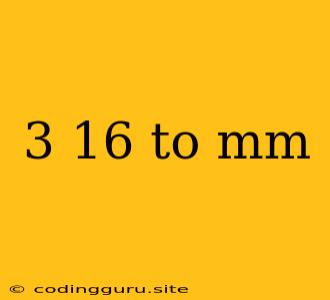Converting 3/16 Inch to Millimeters: A Simple Guide
The question of converting 3/16 inch to millimeters might seem simple, but it's a common task in various fields, especially when dealing with measurements in different systems. This guide will break down the conversion process, provide a clear understanding of the relationship between inches and millimeters, and equip you with the knowledge to perform future conversions effortlessly.
Understanding the Conversion Factor
The core of converting 3/16 inch to millimeters lies in understanding the relationship between the two units.
- 1 inch is equivalent to 25.4 millimeters.
This conversion factor forms the basis of our calculation.
The Conversion Process
- Fraction to Decimal: Convert the fraction 3/16 to a decimal. This gives us 0.1875.
- Multiply by Conversion Factor: Multiply the decimal value (0.1875 inches) by the conversion factor (25.4 millimeters/inch).
Calculation: 0.1875 inches * 25.4 millimeters/inch = 4.7625 millimeters
Therefore, 3/16 inch is equal to 4.7625 millimeters.
Practical Applications
This conversion is crucial in various scenarios:
- Engineering and Design: When working with blueprints or technical drawings, ensuring consistent units across the design is crucial.
- Manufacturing: Precision is vital in manufacturing, and converting units correctly helps maintain accuracy and consistency.
- Construction: From building materials to measuring distances, accurate conversions are essential for smooth construction projects.
Tips for Accurate Conversions
- Use a Calculator: Utilizing a calculator can significantly reduce the risk of calculation errors.
- Online Converters: Numerous online converters are available for quick and easy conversions.
- Memorize Key Conversion Factors: Remembering the fundamental conversion factors, like 1 inch = 25.4 millimeters, can be incredibly helpful.
Conclusion
Converting 3/16 inch to millimeters involves a straightforward process using the fundamental conversion factor. By understanding this relationship, you can confidently perform conversions across various applications, ensuring accurate measurements and seamless transitions between units.
